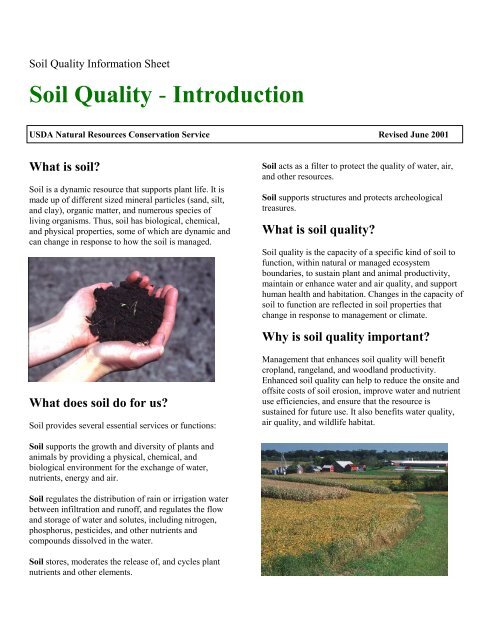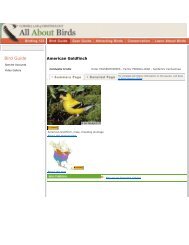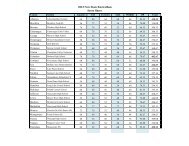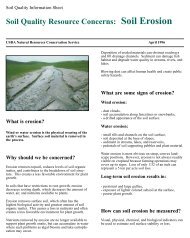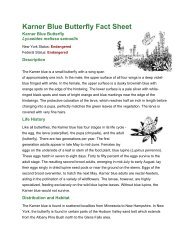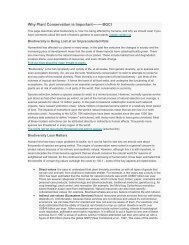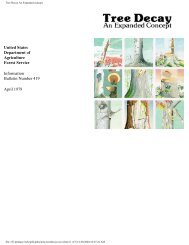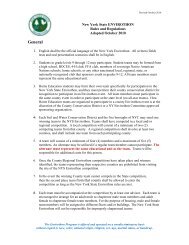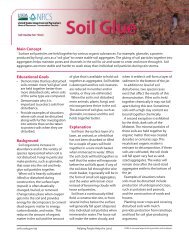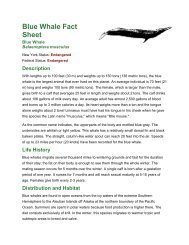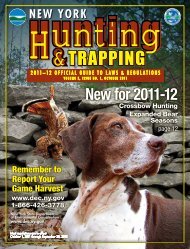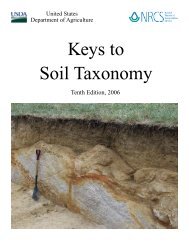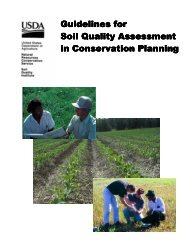Soil Quality Information Sheet - NRCS Soils - US Department of ...
Soil Quality Information Sheet - NRCS Soils - US Department of ...
Soil Quality Information Sheet - NRCS Soils - US Department of ...
Create successful ePaper yourself
Turn your PDF publications into a flip-book with our unique Google optimized e-Paper software.
<strong>Soil</strong> <strong>Quality</strong> <strong>Information</strong> <strong>Sheet</strong><br />
<strong>Soil</strong> <strong>Quality</strong> - Introduction<br />
<strong>US</strong>DA Natural Resources Conservation Service Revised June 2001<br />
What is soil<br />
<strong>Soil</strong> is a dynamic resource that supports plant life. It is<br />
made up <strong>of</strong> different sized mineral particles (sand, silt,<br />
and clay), organic matter, and numerous species <strong>of</strong><br />
living organisms. Thus, soil has biological, chemical,<br />
and physical properties, some <strong>of</strong> which are dynamic and<br />
can change in response to how the soil is managed.<br />
<strong>Soil</strong> acts as a filter to protect the quality <strong>of</strong> water, air,<br />
and other resources.<br />
<strong>Soil</strong> supports structures and protects archeological<br />
treasures.<br />
What is soil quality<br />
<strong>Soil</strong> quality is the capacity <strong>of</strong> a specific kind <strong>of</strong> soil to<br />
function, within natural or managed ecosystem<br />
boundaries, to sustain plant and animal productivity,<br />
maintain or enhance water and air quality, and support<br />
human health and habitation. Changes in the capacity <strong>of</strong><br />
soil to function are reflected in soil properties that<br />
change in response to management or climate.<br />
Why is soil quality important<br />
What does soil do for us<br />
<strong>Soil</strong> provides several essential services or functions:<br />
Management that enhances soil quality will benefit<br />
cropland, rangeland, and woodland productivity.<br />
Enhanced soil quality can help to reduce the onsite and<br />
<strong>of</strong>fsite costs <strong>of</strong> soil erosion, improve water and nutrient<br />
use efficiencies, and ensure that the resource is<br />
sustained for future use. It also benefits water quality,<br />
air quality, and wildlife habitat.<br />
<strong>Soil</strong> supports the growth and diversity <strong>of</strong> plants and<br />
animals by providing a physical, chemical, and<br />
biological environment for the exchange <strong>of</strong> water,<br />
nutrients, energy and air.<br />
<strong>Soil</strong> regulates the distribution <strong>of</strong> rain or irrigation water<br />
between infiltration and run<strong>of</strong>f, and regulates the flow<br />
and storage <strong>of</strong> water and solutes, including nitrogen,<br />
phosphorus, pesticides, and other nutrients and<br />
compounds dissolved in the water.<br />
<strong>Soil</strong> stores, moderates the release <strong>of</strong>, and cycles plant<br />
nutrients and other elements.
How is soil quality evaluated<br />
<strong>Soil</strong> quality is evaluated separately for each individual<br />
soil using soil quality indicators that reflect changes in<br />
the capacity <strong>of</strong> the soil to function. Useful indicators are<br />
those that are sensitive to change, and change in<br />
response to management. The type and number <strong>of</strong><br />
indicators used depends on the scale <strong>of</strong> the evaluation<br />
(i.e., field, farm, watershed, or region) and the soil<br />
functions <strong>of</strong> interest. For example, infiltration rate and<br />
aggregate stability help indicate the capacity <strong>of</strong> the soil<br />
to intake water and resist run<strong>of</strong>f and erosion. Changes in<br />
soil organic matter, including active organic carbon or<br />
particulate soil organic matter, may indicate changes in<br />
productivity. Increased bulk density may reflect limits to<br />
root growth, seedling emergence, and water infiltration.<br />
Measurements <strong>of</strong> indicators can be made with simple to<br />
somewhat complex field tests, or sophisticated<br />
laboratory analyses.<br />
To evaluate soil quality, indicators can be assessed at<br />
one point in time or monitored over time to establish<br />
trends.<br />
An assessment provides information about the current<br />
functional status or quality <strong>of</strong> the soil. The assessment<br />
must start with an understanding <strong>of</strong> the standard,<br />
baseline value, or reference value to be used for<br />
comparison. Assessments can be made to help identify<br />
areas where problems occur, to identify areas <strong>of</strong> special<br />
interest, or to compare fields under different<br />
management systems. Land managers can use this<br />
information, along with data from soil surveys, fertility<br />
tests, and other resource inventory and monitoring data,<br />
to make management decisions.<br />
Monitoring <strong>of</strong> soil quality indicators over time<br />
identifies changes or trends in the functional status or<br />
quality <strong>of</strong> the soil. Monitoring can be used to determine<br />
the success <strong>of</strong> management practices or the need for<br />
additional management changes or adjustments.<br />
What concerns relate to soil quality<br />
Evaluating soil quality can improve the response to<br />
many resource concerns, including those listed below.<br />
For further information, refer to other <strong>Soil</strong> <strong>Quality</strong><br />
<strong>Information</strong> <strong>Sheet</strong>s.<br />
• Loss <strong>of</strong> soil by erosion<br />
• Deposition <strong>of</strong> sediment by wind or floodwaters<br />
• Compaction <strong>of</strong> layers near the surface<br />
• Degradation <strong>of</strong> soil aggregates or soil structure<br />
• Reduced infiltration and increased run<strong>of</strong>f<br />
• Crusting <strong>of</strong> the soil surface<br />
• Nutrient loss or imbalance<br />
• Pesticide carryover<br />
• Buildup <strong>of</strong> salts<br />
• An unfavorable change in pH<br />
• Loss <strong>of</strong> organic matter<br />
• Reduced biological activity<br />
• Poor residue breakdown<br />
• Infestation by weeds or pathogens<br />
• Excessive wetness<br />
• Increased water-repellency <strong>of</strong> soils due to fire<br />
• Reduced water quality<br />
• Greenhouse gas emissions<br />
The full series <strong>of</strong> <strong>Soil</strong> <strong>Quality</strong> <strong>Information</strong> <strong>Sheet</strong>s is available at http://soils.usda.gov/sqi.<br />
This <strong>Sheet</strong> was prepared by the <strong>Soil</strong> <strong>Quality</strong> Institute in cooperation with the National <strong>Soil</strong> Survey Center, <strong>NRCS</strong>, <strong>US</strong>DA;<br />
and the National <strong>Soil</strong> Tilth Laboratory, Agricultural Research Service, <strong>US</strong>DA<br />
The United States <strong>Department</strong> <strong>of</strong> Agriculture (<strong>US</strong>DA) prohibits discrimination in its programs on the basis <strong>of</strong> race, color, national origin, sex, religion, age,<br />
disability, political beliefs, and marital or familial status. (Not all prohibited bases apply to all programs.) Persons with disabilities who require alternative means for<br />
communication <strong>of</strong> program information (braille, large print, audiotape, etc.) should contact the <strong>US</strong>DA Office <strong>of</strong> Communications at (202) 720-2791.<br />
To file a complaint, write the Secretary <strong>of</strong> Agriculture, U.S. <strong>Department</strong> <strong>of</strong> Agriculture, Washington, D.C., 20250, or call (202) 720-7327 (voice) or (202) 720-1127<br />
(TDD). <strong>US</strong>DA is an equal employment opportunity employer.


